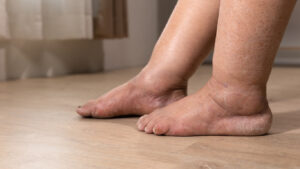The Best Self-Care Practices for Managing Lymphedema
Definition of Lymphedema
Lymphedema is characterized by the buildup of lymph fluid in the tissues, leading to swelling, often in the arms, legs, or other body parts. It can occur when the lymphatic system is compromised due to damage, illness, or surgery. In particular, individuals who have undergone cancer treatment, particularly breast cancer treatment, are at a higher risk of developing secondary lymphedema, as the lymph nodes may be removed or damaged during the process. Lymphedema is typically a chronic condition, and while it cannot be fully cured, effective management can significantly improve the quality of life for those affected.
Importance of Self-Care in Managing Lymphedema
Self-care is pivotal in managing lymphedema, as consistent and proactive care can reduce swelling, prevent complications, and improve overall well-being. For individuals with lymphedema, self-care involves a combination of lifestyle adjustments, home treatments, and proper medical guidance. By adopting effective self-care practices, individuals can help prevent the progression of lymphedema, manage symptoms, and reduce flare-ups, enhancing their daily life and comfort.
Overview of the Blog Post Structure
This article will explore the best self-care practices for managing lymphedema. From compression therapy and exercise to skincare, this guide provides practical advice for managing symptoms and improving the overall management of lymphedema. We will also discuss the importance of lifestyle modifications, including dietary considerations and stress management techniques, to support lymphedema management.
Understanding Lymphedema
Causes and Risk Factors
Lymphedema occurs when the lymphatic system, responsible for draining excess fluids and waste, becomes damaged or obstructed. There are two primary types of lymphedema: primary and secondary. Primary lymphedema is a genetic condition where the lymphatic system fails to develop correctly. Secondary lymphedema, on the other hand, is more common and typically occurs due to an injury or surgical procedure, particularly after cancer treatment. Risk factors for developing lymphedema include the removal or radiation of lymph nodes, obesity, infections, and chronic conditions such as cancer and surgery-related complications.
Symptoms and Effects on Daily Life
The most noticeable symptom of lymphedema is swelling in the affected area, ranging from mild to severe. This swelling, often in the limbs, can cause pain, discomfort, and difficulty moving. Over time, lymphedema can lead to the thickening of the skin (fibrosis), and in some cases, it can cause recurring infections and skin ulcers. The impact of lymphedema on daily life is significant, as individuals may experience physical limitations, difficulty performing everyday tasks, and emotional distress due to the visible effects of the swelling.
The Role of Self-Care in Symptom Management
While there is no cure for lymphedema, managing the condition through self-care can significantly reduce symptoms and prevent further complications. A well-rounded approach to lymphedema self-care includes practices that help manage swelling, maintain healthy skin, and promote overall health. Incorporating regular physical activity, compression therapy, skincare routines, and dietary changes can improve the body’s ability to manage fluid buildup and minimize the negative impact of the condition.
Best Self-Care Practices
Compression Therapy
Compression therapy is one of the most effective self-care practices for managing lymphedema. It involves wearing specialized garments, such as compression sleeves or stockings, that apply gentle pressure to the affected area. Compression therapy helps promote lymphatic drainage, reduce swelling, and prevent fluid buildup in the limbs.
Types of Compression Garments
Compression garments come in various forms, including stockings, sleeves, and wraps. They are designed to provide consistent pressure on the affected limb, supporting the natural flow of lymph fluid. Depending on the severity of the lymphedema, different compression levels are available, ranging from light to vigorous. Working with a healthcare provider or a lymphedema specialist is essential to determine the appropriate type and level of compression for your specific condition.
Proper Usage and Fitting
Proper fitting and usage of compression garments are crucial for their effectiveness. The garments should fit snugly without causing discomfort or restricting blood flow. It’s essential to wear them consistently, as directed by your healthcare provider, typically during the day or while performing certain activities. Regularly washing and maintaining the compression garments is also essential to ensure they continue to provide adequate support.
Exercise and Physical Activity
Exercise is another essential aspect of self-care for managing lymphedema. Physical activity helps improve lymphatic drainage, reduce swelling, and maintain overall health. Exercises that involve the affected limb are particularly beneficial for stimulating the lymphatic vessels and promoting fluid movement.
Recommended Exercises
Low-impact exercises are generally recommended for individuals with lymphedema. These can include walking, swimming, cycling, and gentle strength training. Exercises that involve movement of the arms and legs, such as stretching, yoga, or resistance band exercises, can be particularly helpful in promoting lymphatic circulation. Avoiding excessive strain or high-impact activities that may lead to injury or exacerbate swelling is crucial.
Importance of Regular Movement
In addition to structured exercises, regular daily movement can help manage lymphedema. Simple activities such as walking, standing up and moving around periodically, or gentle stretching can all encourage lymphatic flow and prevent fluid from accumulating in the affected area. Staying active helps prevent the stiffness and discomfort associated with prolonged swelling, improving physical and emotional well-being.
Skin Care and Hygiene
Skin care is a critical component of managing lymphedema, as the skin in the affected area is more vulnerable to infections, dryness, and irritation. Taking care of the skin can reduce the risk of complications and keep it in optimal condition.
Daily Skin Care Routines
Daily skin care routines should include gentle cleansing, moisturizing, and keeping the skin dry. Using hypoallergenic, fragrance-free products can help prevent irritation. Moisturizing the skin regularly is important to maintain hydration and prevent cracking or dryness, which can increase the risk of infection. Individuals with lymphedema should also avoid excessive heat or sun exposure, as this can worsen swelling.
Preventing Infections and Complications
Infections, such as cellulitis, are a common complication of lymphedema. Preventing infection requires practicing proper hygiene and being vigilant for signs of skin irritation or cuts. When cuts or wounds occur, it’s essential to clean them immediately and monitor for any signs of infection, such as redness, warmth, or pus. Seeking prompt medical treatment for infections can help prevent further complications and reduce the severity of flare-ups.
Lifestyle Modifications
Dietary Considerations
Dietary changes can significantly impact the management of lymphedema. While no specific diet can cure lymphedema, certain dietary habits can help reduce inflammation and promote overall health.
Anti-Inflammatory Foods
Incorporating anti-inflammatory foods into the diet can be beneficial for individuals with lymphedema. These include fruits and vegetables, whole grains, lean proteins, and healthy fats like olive oil and avocados. Omega-3 fatty acids, found in fatty fish like salmon and flaxseeds, are particularly helpful in reducing inflammation. Avoiding processed foods, excessive salt, and refined sugars can help reduce fluid retention and support lymphatic health.
Hydration and Its Importance
Staying hydrated is essential for managing lymphedema. Proper hydration helps maintain fluid balance in the body and supports the function of the lymphatic system. Drinking water throughout the day can prevent fluid buildup and encourage lymphatic drainage. However, balancing hydration with dietary considerations is crucial, particularly when managing sodium intake.
Stress Management Techniques
Managing stress is a crucial part of self-care for individuals with lymphedema. Chronic stress can exacerbate the symptoms of lymphedema, leading to increased swelling and discomfort. Adopting stress management techniques can help reduce the emotional burden of living with this chronic condition.
Mindfulness and Relaxation Practices
Mindfulness practices such as meditation, deep breathing exercises, and yoga can help reduce stress and improve mental clarity. These practices encourage relaxation and can help individuals with lymphedema manage the emotional and physical strain of the condition. Incorporating these practices into a daily routine can improve overall well-being and promote better lymphatic function.
Support Groups and Community Resources
Connecting with others who are living with lymphedema can be incredibly beneficial. Support groups and community resources provide a space to share experiences, learn new coping strategies, and receive emotional support. Many individuals find that sharing their journey with others helps alleviate feelings of isolation and empowers them to manage their symptoms better.
Final Thoughts on Seeking Professional Guidance and Support
While self-care is vital, it’s also essential to work with healthcare providers who specialize in lymphedema. A lymphedema therapist or specialist can help you develop a treatment plan that addresses the physical and emotional aspects of managing the condition. Lymphedema is a chronic condition, but it’s possible to live well and manage symptoms effectively with the proper support and self-care.
FAQs
Q: What are the best lymphedema self-care practices I can implement at home?
A: Effective lymphedema self-care practices include maintaining a healthy weight, engaging in regular exercise, practicing manual lymphatic drainage, wearing compression garments, and keeping your skin moisturized to prevent lymphedema symptoms.
Q: How does complete decongestive therapy help in treating lymphedema?
A: Complete decongestive therapy is a comprehensive treatment that combines manual lymphatic drainage, compression therapy, exercise, and skincare to reduce swelling and improve lymphatic function in lymphedema patients.
Q: What are the stages of lymphedema, and how can they affect treatment options?
A: The stages of lymphedema range from mild swelling (Stage 1) to severe fibrosis and skin changes (Stage 3). Understanding these stages is crucial for tailoring effective treatment for lymphedema, as earlier stages may respond better to conservative measures.
Q: How can I manage lymphedema flare-ups at home?
A: To manage lymphedema flare-ups at home, you can elevate the affected limb, perform gentle exercises, apply compression garments, and practice your lymphedema self-care routines consistently.
Q: What role does lymphatic drainage play in lymphedema treatment?
A: Lymphatic drainage, particularly through manual lymphatic drainage techniques, helps to stimulate the movement of lymph fluid, reduce swelling, and alleviate discomfort in lymphedema patients.
Q: Can breast cancer treatment lead to lymphedema, and how can it be prevented?
A: Yes, breast cancer treatment, including surgery and radiation, can lead to lymphedema due to damage to the lymphatic system. Preventative measures include maintaining a healthy lifestyle and following a self-care routine as advised by your doctor or lymphedema specialist.
Q: What are some common lymphedema symptoms to be aware of?
A: Common lymphedema symptoms include swelling of the affected limb, a feeling of heaviness, tightness or discomfort, recurrent infections, and changes in skin texture. Early detection is key for effective treatment for lymphedema.
Q: How can I incorporate lymphedema self-care into my daily routine?
A: To incorporate lymphedema self-care into your daily routine, establish a self-care schedule that includes exercises, skin care, and wearing compression garments as part of your regular activities.
Q: What are the treatment options available for lower body lymphedema?
A: Treatment options for lower body lymphedema include complete decongestive therapy, compression therapy, manual lymphatic drainage, exercise, and skin care practices to effectively manage swelling and improve quality of life.





